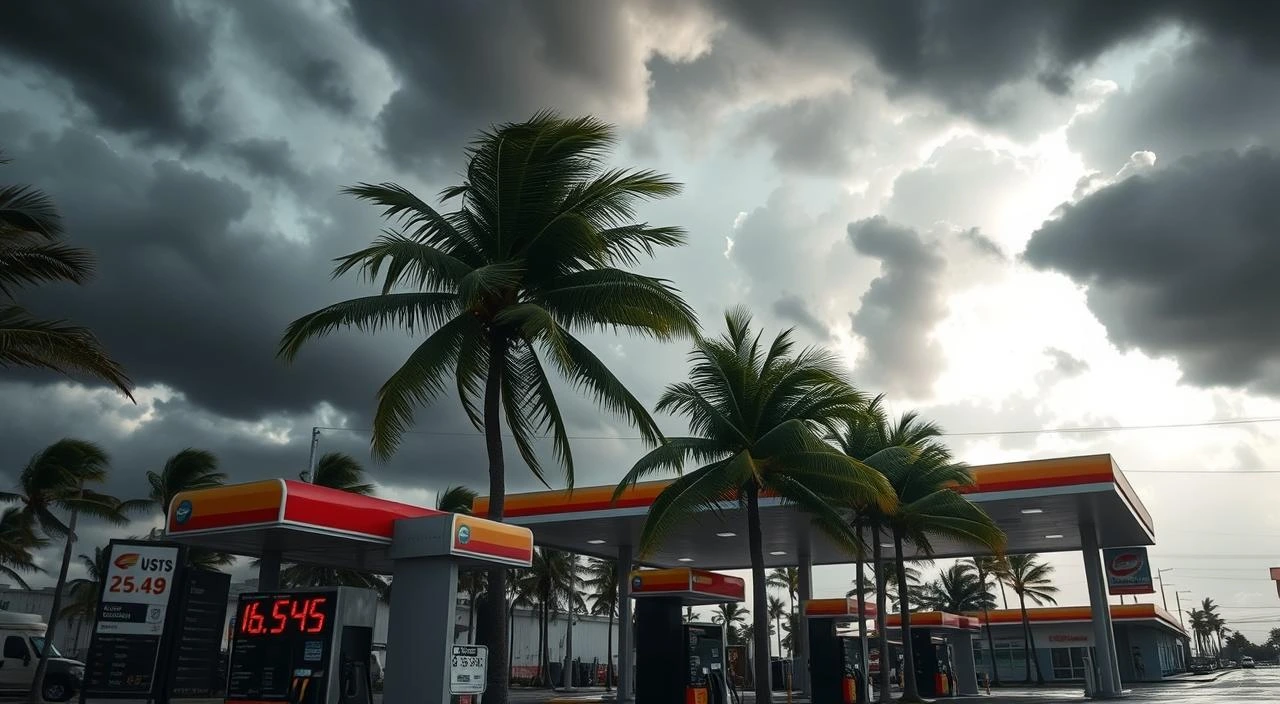Florida gas prices have stayed the same, even with Hurricane Milton’s challenges. The hurricane could have caused problems with fuel supply. But, the energy sector’s quick action and readiness kept prices steady for everyone.
Key Takeaways
- Florida gas prices have held steady despite the impact of Hurricane Milton
- The energy sector’s resilience and preparedness have contributed to price stability
- Potential disruptions to energy infrastructure were mitigated by contingency plans and emergency protocols
- Regional economics and consumer prices have been minimally affected by the natural disaster
- The article highlights the importance of the energy sector’s ability to withstand natural disasters and maintain fuel supply
Overview of Hurricane Milton’s Impact
When Hurricane Milton hit Florida, people and businesses were worried about energy problems. They watched the storm’s path and strength closely. This was because it could affect the power grid and fuel supply a lot.
Storm’s Path and Intensity
Hurricane Milton was a strong Category 3 storm. It moved across Florida, bringing strong winds, heavy rain, and flooding risks. Its path went through important places for energy, like pipelines, refineries, and power plants.
Potential Disruptions to Energy Infrastructure
The energy sector in Florida is very important for the economy. Any problems here could cause big issues. Hurricane Milton threatened the energy system, possibly causing fuel shortages, power cuts, and problems with energy delivery.
| Potential Impact | Likelihood |
|---|---|
| Damage to pipelines and refineries | High |
| Power outages and grid instability | Moderate |
| Disruptions to fuel transportation and distribution | High |
The table shows how Hurricane Milton could affect Florida’s energy system. It highlights the chances of each problem happening. These factors are key to understanding how well the energy sector can handle the storm.
Florida Gas Prices Hold Steady Despite Hurricane Milton Challenges
When Hurricane Milton hit Florida, it caused a lot of trouble. But one thing that didn’t change much was the florida gas prices. The state’s energy sector showed it could handle the storm, keeping gas prices steady for everyone.
Factors Contributing to Price Stability
Several things helped keep florida gas prices stable during the hurricane. The energy industry had good plans in place to deal with the storm. They made quick changes to their supply lines to keep gas flowing.
The energy sector’s resilience was key. They had spent a lot on infrastructure and emergency plans. This helped keep prices stable, even when the storm was at its worst.
Also, working together was important. The government, energy companies, and local groups all helped out. Their teamwork helped keep gas prices steady, protecting consumers from big price jumps.
The steady florida gas prices during Hurricane Milton show the energy sector’s strength. They proved they can keep fuel flowing, even in tough times, for everyone in Florida.
Consumer Prices and Regional Economics
Hurricane Milton hit Florida hard, but the state’s economy stayed strong. Gas prices, in particular, were a key factor. Florida kept gas prices steady, showing its solid energy system and quick action.
Gas prices in Florida barely changed after the hurricane. The national average is around $3.20 per gallon. But Florida’s prices stayed the same. This is different from California, where prices hit $4.68 per gallon, the highest in the country.
Keeping gas prices stable helped Florida’s economy a lot. It made sure people could buy what they needed without paying too much. This helped the state bounce back quickly after the hurricane.
| State | Average Gas Price (Regular Unleaded) |
|---|---|
| Florida | $3.20 per gallon |
| California | $4.68 per gallon |
| National Average | $3.20 per gallon |
Florida’s economy showed great strength against Hurricane Milton. Keeping gas prices stable was key. This helped both businesses and families during a tough time.
Energy Sector Resilience and Preparedness
When Hurricane Milton hit Florida, the energy sector showed it was ready. It made smart supply chain changes and had strong plans for emergencies. This kept fuel prices steady during the storm.
Supply Chain Adjustments
Before the hurricane, energy companies in Florida made key changes. They moved fuel routes, increased storage, and worked with transport teams. This was to avoid any fuel delivery problems.
Contingency Plans and Emergency Protocols
Florida’s energy sector had plans for emergencies. They were put into action as the hurricane got closer. They moved important equipment and people, set up emergency lines, and worked with local officials to fix things fast.
The energy sector’s quick action helped keep fuel prices low. Even though the storm damaged a lot and affected many, the sector’s readiness helped everyone get the fuel they needed.
“The energy sector’s swift and coordinated response to Hurricane Milton highlights the need for being ready for disasters,” said an industry expert.
Conclusion
Florida’s gas prices stayed steady during Hurricane Milton. This shows how well the state’s energy sector is prepared. Despite the storm, gas prices didn’t go up, proving the industry’s ability to handle tough times.
The energy sector had plans ready for emergencies. They quickly changed their supply chain to keep prices stable. This also shows how natural disasters affect our economy and local areas.
As natural disasters get more common, we need to make the energy sector stronger. This study helps us see how important it is to be ready. By working together, we can keep our energy systems reliable and protect our economy during crises.
FAQ
What factors contributed to Florida’s gas price stability during Hurricane Milton?
Florida’s gas prices stayed the same during Hurricane Milton. This was thanks to the energy sector’s quick thinking and planning. They adjusted their supply chains and had emergency plans ready.
How did Hurricane Milton’s path and intensity impact the region’s energy infrastructure?
Hurricane Milton’s path and strength could have hurt Florida’s energy systems. This was a big reason why gas prices stayed stable during the storm.
What is the relationship between consumer prices and regional economics in the context of Hurricane Milton’s impact?
The article looks at how steady gas prices affected people and the local economy during and after Hurricane Milton. It shows how disasters, energy systems, and the economy work together to keep prices stable.
How did the energy sector’s resilience and preparedness contribute to Florida’s gas price stability?
The energy sector’s quick actions and plans helped keep fuel costs steady during Hurricane Milton. This included adjusting supply chains and having emergency protocols in place.

My name is Jakir, I am a content writer, content creator, I give business, sports, finance, trending news and I have 10 years of experience in this and this is my blog goldennews24.com.










